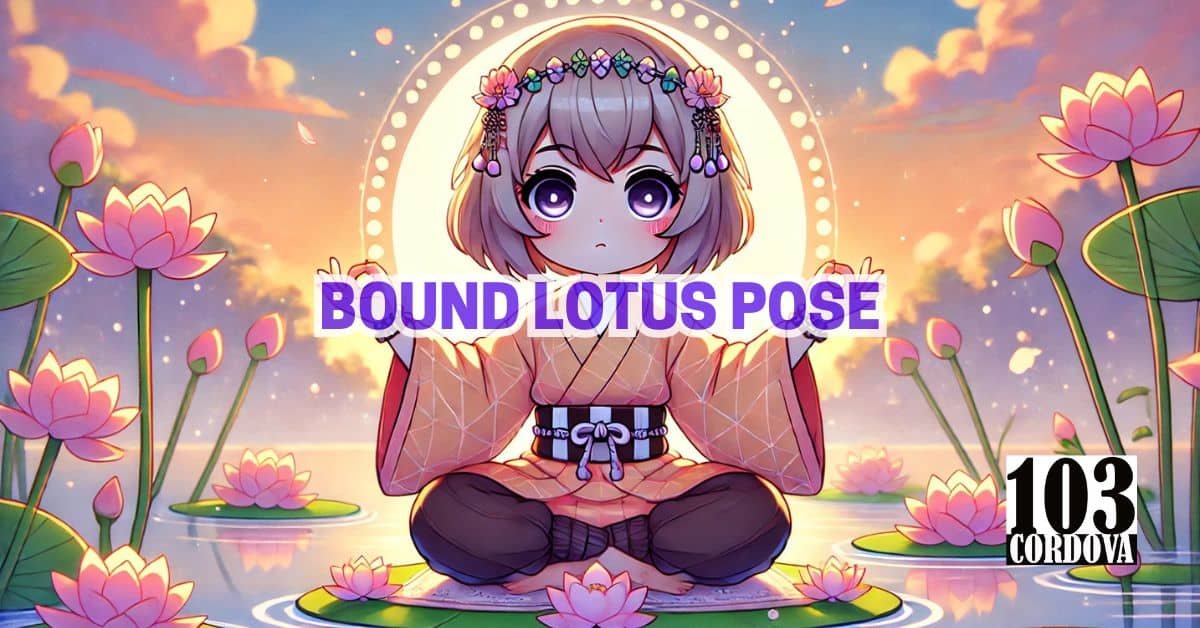Bound Lotus Pose, or Baddha Padmasana, is an advanced yoga pose that combines flexibility, strength, and balance.
In this pose, the legs are crossed tightly with the feet resting on the opposite thighs, and the hands clasp behind the back.
This deep stretch opens the hips and shoulders while also challenging the body’s alignment.
It is often used in meditation practices due to its calming effect on the mind.
Although it appears simple, the pose requires preparation and care to perform correctly.
1. Why Hip Flexibility is Key for Bound Lotus Pose
Hip flexibility is crucial for performing Bound Lotus Pose safely and effectively.
The hips need to rotate externally and support the legs’ crossed position without strain.
Without sufficient flexibility, you may experience discomfort or risk injury.
Consistently practicing hip-opening stretches, such as butterfly pose or pigeon pose, can help improve mobility.
Flexible hips also enhance overall movement and reduce tension in surrounding muscles like the lower back and thighs.
🧘 The Benefits of Incorporating Bolster Yoga Poses Into Your Routine
2. Understanding the Muscles Targeted in Bound Lotus Pose
Bound Lotus Pose primarily stretches the muscles of the hips, including the hip flexors, glutes, and adductors.
It also engages the thighs and knees to maintain the crossed leg position.
The pose promotes flexibility in the shoulders and chest as the hands reach back to clasp the toes or feet.
Stretching these muscles helps to release tension built up from daily activities like sitting or walking.
Being aware of these muscle groups can guide you in executing the pose with proper form and alignment.
🧘 The Surprising Health Benefits of Ruchaka Yoga You Need to Know
3. Step-by-Step Guide to Practicing Bound Lotus Pose
1. Begin seated on the floor with your legs extended straight in front of you.
2. Bend your right knee, bringing the foot to rest on the left thigh.
Repeat this with the left knee, placing the foot on the right thigh.
3. Gently lean forward to reach your arms behind your back and clasp your toes or feet.
4. Keep your spine upright and focus on deep, steady breaths to help relax into the pose.
5. Hold the position for several breaths, then release slowly to avoid any strain on your joints or muscles.
🧘 How the Benefits of Ardha Matsyendrasana Yoga Can Enhance Your Daily Life
4. How Bound Lotus Pose Benefits Your Hips and Lower Body
This pose stretches and strengthens key muscles in the hips, thighs, and lower back.
It improves the mobility of the hip joints, making everyday movements like walking and sitting more comfortable.
The pose can also help relieve tightness caused by prolonged sitting or high-intensity exercise.
By improving circulation in the lower body, it promotes faster recovery and reduces muscle fatigue.
Regular practice of Bound Lotus Pose can lead to better balance, stability, and flexibility in the lower body.
🧘 Tantra Yoga Vs. Hatha Yoga: Understanding the Key Differences
5. Improving Posture and Spinal Alignment with Bound Lotus Pose
Maintaining proper alignment in Bound Lotus Pose helps enhance your posture over time.
The pose requires you to engage the core muscles to support the spine’s natural curve.
This alignment reduces unnecessary strain on the lower back and shoulders, which are common problem areas for many people.
Practicing regularly can help correct slouching and promote a more upright posture in daily life.
Strengthening the core and improving spinal stability can also reduce the risk of back pain.
🧘 How to Find the Right Yoga Teacher for Pregnancy: Tips for Expecting Mothers
6. The Mental and Emotional Benefits of Bound Lotus Pose
Bound Lotus Pose encourages focus and mindfulness, helping to calm the mind and reduce stress.
Holding the pose requires concentration, which can bring a sense of mental clarity and relaxation.
Many people find that it promotes a meditative state, making it an excellent addition to yoga or meditation routines.
Deep, controlled breathing during the pose can lower anxiety and improve emotional well-being.
Over time, this practice can help you feel more grounded and balanced in your daily life.
🧘 How to Deepen Yoga Practice: Techniques for Mindfulness and Focus
7. Overcoming Common Challenges in Bound Lotus Pose
Tight hips and knees are common obstacles to achieving Bound Lotus Pose.
To ease into the pose, you can practice preparatory stretches like seated forward bends and half lotus.
Using props like yoga straps can also assist in reaching the hands behind the back.
It’s important to listen to your body and avoid pushing into pain, as this can cause injury.
Gradual progress and consistent practice are the best ways to overcome these challenges safely.
🧘 The Spiritual and Personal Growth Benefits of Being a Yoga Teacher
8. Bound Lotus Pose Variations and Modifications for Beginners
Beginners may find it difficult to fully cross their legs or clasp their hands in Bound Lotus Pose.
Modifications like placing one leg in a half-lotus position or using a strap to bridge the gap between hands and feet can help.
Supporting the hips with a cushion can ease discomfort and improve alignment.
These adjustments allow practitioners to experience the benefits of the pose without forcing their bodies.
Starting with variations builds confidence and flexibility over time.
🧘 Why You Should Invite a Yoga Teacher To Come Home for Personalized Practice
9. Safety Tips and Precautions When Practicing Bound Lotus Pose
Always warm up before attempting Bound Lotus Pose to prevent strain or injury.
Avoid this pose if you have knee or hip injuries, or consult with a qualified yoga instructor for modifications.
Focus on gradual progress rather than forcing the body into the full expression of the pose.
Use props as needed to support your practice and avoid discomfort.
Remember to breathe deeply and evenly throughout to keep the body relaxed and reduce tension.
🧘 Discover the Essence of Yoga
10. Tips for Progressing in Bound Lotus Pose
Progressing in Bound Lotus Pose requires patience and a consistent stretching routine.
Incorporate hip-opening poses like lizard pose and cow face pose into your practice to prepare your body.
Focus on maintaining proper alignment and using props to support your form.
Eventually, as flexibility increases, you can gradually work towards the full expression of the pose.
Celebrate small improvements to stay motivated and avoid frustration.
🧘 Best Yoga Studio in Marikina City
💡 Conclusion
Bound Lotus Pose is a valuable practice for building strength, flexibility, and mental focus.
By approaching it with patience and care, you can safely enjoy its benefits and make steady progress.
The pose challenges both the body and mind, offering opportunities for growth in many areas.
Incorporating it into your routine can improve physical and emotional well-being over time.
Remember to honor your limits and celebrate each step forward in your practice.
🧘 Our Services
Discover the transformative power of yoga at our studio, conveniently located at 103 Cordova Tower, Marquinton Residences, Cirma Street, Sto. Nino, Marikina City.
We offer yoga classes for all ages, designed to promote balance, flexibility, and overall well-being in a supportive environment.
Whether you’re a beginner or an experienced yogi, our expert instructors will guide you every step of the way.
Reach out to us at 09176225780, through our Facebook page, or via the contact form on our site to start your journey.
Join us and embrace a healthier, more centered lifestyle today!

